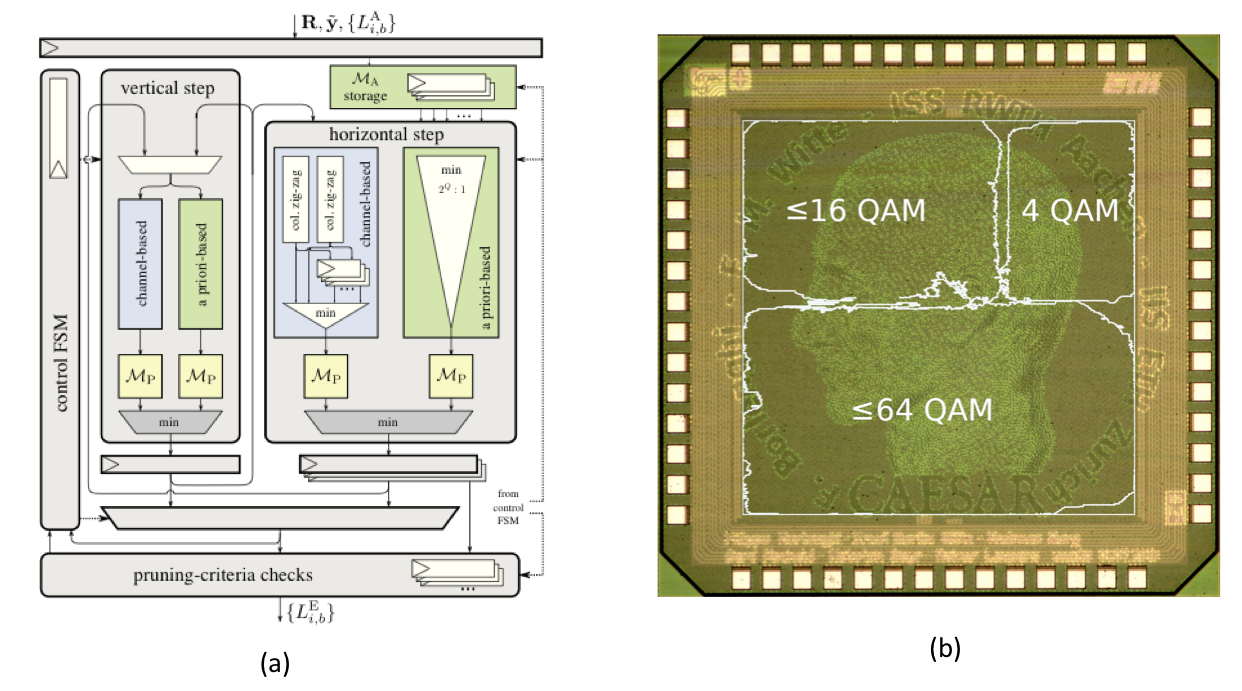Wireless Communication Systems
Integrated nanosystems need to communicate with the external world via efficient interfaces. The use of low-power integrated wireless links supports connectivity of the nanosystem without the use of wired communication structures, which are bulky and space-consuming. Moreover, wired communication consumes a significant part of the power budget, especially through the I/O pads. To achieve higher spectral efficiency new transmission techniques like MIMO will be established. However, this will increase the workload even further. Thus, there is a strong need for efficient wireless baseband receivers. The overall efficiency of a baseband receiver depends on:
- Communications efficiency: expressed by the spectral efficiency and signal-to-noise ratio (SNR). The requirements on the communications efficiency have the largest impact on the selected baseband processing algorithms.
- Implementation efficiency: related to silicon area, power and energy. Here, the energy efficiency is the biggest challenge due to the limited available battery power in many devices.
- Flexibility: in software defined radio, receivers should be flexible/configurable at run-time since they have to support multiple standards. There are various silicon implementation styles ranging from general purpose architectures, over DSPs and ASIPs down to fully physically optimized IP blocks which strongly differ in their implementation efficiency but also in their flexibility. Thus, for each building block of the receiver a detailed analysis of algorithmic flexibility and service parameter flexibility requirements has to be carried out. Service parameter flexibility for a specific channel code is for example varying code rates, block sizes with respect to a given throughput. The goal is to find an optimal implementation style with respect to a flexibility/cost trade-off. Thus, advanced baseband receivers are heterogeneous multi- core architectures implemented in different design styles.
VLSI Implementation of Iterative MIMO Receiver Components
Multiple-input multiple-output (MIMO) transmission can significantly increase the data rate in wireless communication systems by spatial multiplexing, without additional usage of limited resources such as bandwidth and transmit power. Unfortunately, in terms of digital baseband processing in the receiver, MIMO also considerably increases the complexity of the detector. Therefore, most circuit implementations accept a sub-optimal communication performance to reduce complexity. Linear detectors, based on zero forcing or minimum mean square error (MMSE) criteria, and successive interference cancellation exhibit low complexity but also poor error-rate performance. Maximum-likelihood performance is approached by hard-output sphere decoders. A further performance gain over hard-output methods is achieved, with additional complexity, by providing soft information, as log-likelihood ratios (LLRs), to the channel decoder.

a) High-level block diagram of the SISO STS SD architecture. b) Chip micrograph: physical implementation of the soft-input soft-output (SISO) single tree-search (STS) sphere decoding (SD) chip christened Cae2sar.
Iterative MIMO detection and decoding is the final hurdle towards approaching channel capacity. Introducing a feedback loop enables a soft-input soft-output (SISO) detector to improve its estimates based on extrinsic information computed by the channel decoder. Unfortunately, the resulting performance gain comes at the expense of a much higher detection complexity compared with non-iterative schemes. Only recently, the first silicon implementation of a SISO MIMO detector has been presented (see figure), based on SISO MMSE parallel interference cancellation (PIC). This algorithm shows considerable communication performance gains over non-iterative detectors, but, like other (quasi-)linear methods, it fails to exploit the spatial diversity by MIMO. This limitation is overcome by SISO single tree-search (STS) sphere decoding (SD), which has max-log maximum a posteriori (MAP) performance and the ability to fully exploit spatial diversity.